Hfrg handcuffing - Study guides, Class notes & Summaries
Looking for the best study guides, study notes and summaries about Hfrg handcuffing? On this page you'll find 9 study documents about Hfrg handcuffing.
All 9 results
Sort by
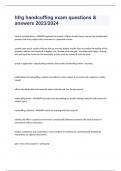
-
hfrg handcuffing exam questions & answers 2023/2024
- Exam (elaborations) • 3 pages • 2023
-
Available in package deal
-
- $8.49
- + learn more
hfrg handcuffing exam questions & answers 2023/2024 tactical considerations - ANSWER-approach to contact- officers should always assume the fundamental premise that every subject they encounter is a potential resistor control upon touch- studies indicate that an arrested subject usually does not realize the totality of the situation until the first handcuff is applied. the "double push principle" simultaneously apply a thumb lock and push the hand into the handcuffs, as they push the h...

-
HFRG CH. 5 Tactical Handcuffing fully answers 2024/2025
- Exam (elaborations) • 2 pages • 2024
- Available in package deal
-
- $9.99
- + learn more
HFRG CH. 5 Tactical HandcuffingIdentify the 3 types of subjects an officer will handcuff - correct answer Totally Cooperative Subject: The most common type of subject that officers will face. Majority of arrests will be misdemeanor. Potentially Uncooperative Subject: The most dangerous subject to handcuff. Usually intoxicated or experienced criminal. Intoxicated subjects account for over 70% of resisting incidents. Have nothing to lose, provide their own form of distraction. Totally Uncoo...
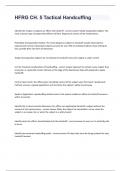
-
HFRG CH. 5 Tactical Handcuffing Question and answers already passed 2024
- Exam (elaborations) • 2 pages • 2024
-
Available in package deal
-
- $14.49
- + learn more
HFRG CH. 5 Tactical Handcuffing Question and answers already passed 2024 Identify the 3 types of subjects an officer will handcuff - correct answer Totally Cooperative Subject: The most common type of subject that officers will face. Majority of arrests will be misdemeanor. Potentially Uncooperative Subject: The most dangerous subject to handcuff. Usually intoxicated or experienced criminal. Intoxicated subjects account for over 70% of resisting incidents. Have nothing to lose, provide their...
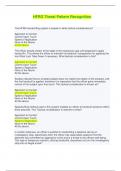
-
HFRG Threat Pattern Recognition Exam - Questions and Answers
- Exam (elaborations) • 22 pages • 2024
-
Available in package deal
-
- $17.99
- + learn more
HFRG Threat Pattern Recognition Exam - Questions and Answers The HFRG handcuffing system is based on what tactical considerations? Approach to Contact Control Upon Touch Speed of Application None of the Above All the above The officer should remain at the edge of the reactionary gap until prepared to apply handcuff's. This allows the officer to maintain his balance in preparation for applying the Iron Wrist Lock Take Down if necessary. What tactical consideration is this? Approach to Contact ...
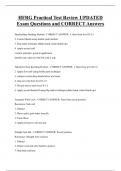
-
HFRG Practical Test Review UPDATED Exam Questions and CORRECT Answers
- Exam (elaborations) • 7 pages • 2024
-
- $7.99
- + learn more
HFRG Practical Test Review UPDATED Exam Questions and CORRECT Answers Handcuffing Standing Method - CORRECT ANSWER- 1. Start from level II-1/2 2. Control thumb using double push method 3. Flip under technique (Shake hand, rotate thumb up) 4. Apply second cuff Control principle: speed in application Double lock when it's TACTICALLY safe Takedown from Kneeling Position - CORRECT ANSWER- 1. Start from level II-1/2 2. Apply first cuff using double push technique 3. (subject resists) drop...
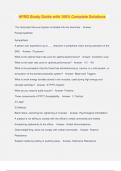
-
HFRG Study Guide with 100% Complete Solutions
- Exam (elaborations) • 7 pages • 2024
- Available in package deal
-
- $11.49
- + learn more
HFRG Study Guide with 100% Complete Solutions The Automatic Nervous System is divided into two branches: - Answer- Parasympathetic Sympathetic A person can experience up to ___ reduction in peripheral vision during activation of the SNS. - Answer- 70 percent What is the optimal heart rate zone for optimal performance? - Answer- Inverted U-Law What is the heart rate zone for optimal performance? - Answer- 115 - 145 What is the perception that the threat has diminished injury, trauma, to a...
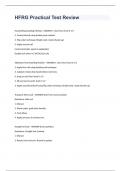
-
HFRG Practical Test Review
- Exam (elaborations) • 7 pages • 2023
-
Available in package deal
-
- $8.99
- + learn more
HFRG Practical Test Review Handcuffing Standing Method - ANSWER-1. Start from level II-1/2 2. Control thumb using double push method 3. Flip under technique (Shake hand, rotate thumb up) 4. Apply second cuff Control principle: speed in application Double lock when it's TACTICALLY safe Takedown from Kneeling Position - ANSWER-1. Start from level II-1/2 2. Apply first cuff using double push technique 3. (subject resists) drop hands below my knees. 4. drag (or exit) from level II-...
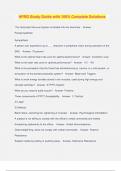
-
HFRG Study Guide with 100% Complete Solutions
- Exam (elaborations) • 7 pages • 2024
- Available in package deal
-
- $11.49
- + learn more
HFRG Study Guide with 100% Complete Solutions The Automatic Nervous System is divided into two branches: - Answer- Parasympathetic Sympathetic A person can experience up to ___ reduction in peripheral vision during activation of the SNS. - Answer- 70 percent What is the optimal heart rate zone for optimal performance? - Answer- Inverted U-Law What is the heart rate zone for optimal performance? - Answer- 115 - 145 What is the perception that the threat has diminished injury, trauma, to a...
BUNDLE - HFRG EXAMS

Did you know that on average a seller on Stuvia earns $82 per month selling study resources? Hmm, hint, hint. Discover all about earning on Stuvia


